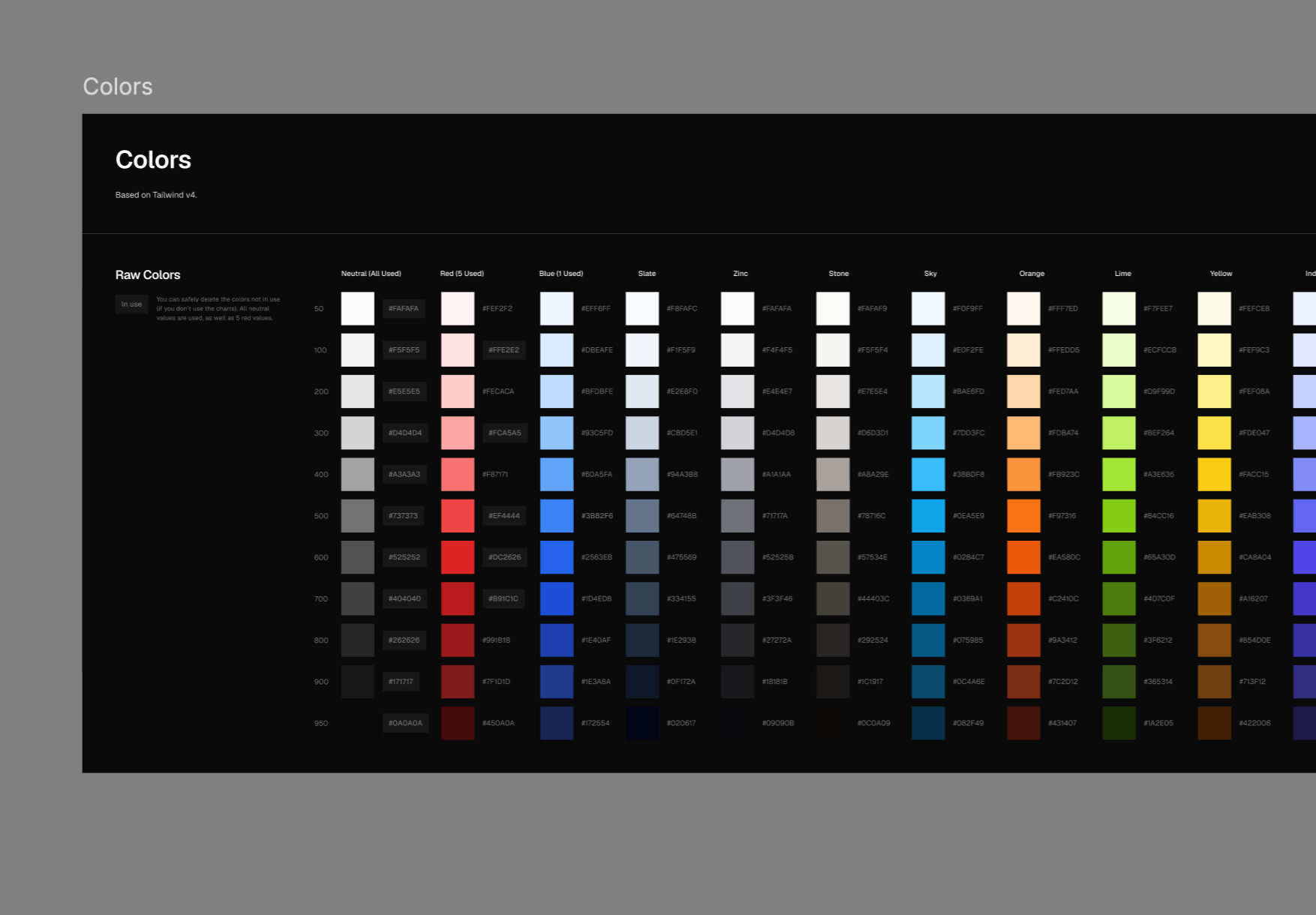Colors
Raw colors
We include all Tailwind 4 colors as Figma variables inside the “Raw colors” collection.

Tailwind colors
We tagged the colors in use visually.
If you don’t need them, you can safely delete the colors not in use. All neutral values are used, as well as 5 red values.
Note: Figma does not support OKCLH, so we are using hex variables.
Theming
The theming variables are based on the shadcn/ui theming docs.
By default, we use the light theme. We ship a dark theme as well.
Change the theme globally by changing the variable mode of the page to dark.
To create your own theme, we recommend adding a new mode in Figma and start customizing the colors.
Need help creating your own theme? We offer design services around this. Check out this page for more details.
We added several variables on top of shadcn/ui’s theming to allow designers to have more control in Figma.
- Within shadcn’s code, the color mix CSS function is often used to mix a variable (or rather CSS custom property) with a color. This is not possible to replicate in Figma.
- Within other parts of the code, color variables are hardcoded instead of using a theming layer. This forced us to come up with new variables for these cases. You will see many more border and background variants than exist in the official CSS, because of combinations made in shadcn docs code that need to be translated to Figma’s variable modes.
The variables that are unofficial are marked as “unofficial”.
Variable tips
Foreground
In general, use foreground for text and icons.
We prefer to use foreground alt (Unofficial) for body text. This is not part of the shadcn/ui official variables but highly recommended design-wise (shadcn does the same in their docs, just not with an “official” variable)
Use foreground muted for muted text.
Backgrounds
A shadcn convention is to not mention that something is a background. So for example “Primary” is actually “Primary background”. We follow this convention.
Accents map to darkness levels where 1 = 100, 2 = 200 etc, with the exception of Accent 0 which maps to neutral-50 in light mode by default.
- Accent 0 - Unofficial - Maps to neutral-50
- Accent (1): maps to 100
- Accent 2: maps to 200
- Accent 3: maps to 300
You might encounter some backgrounds set to very light colors such as 0.01%. What’s up with that?0 The underlying reason is that without a fill, the shadow (usually used for focus styles) doesn’t render.
Borders
Borders maps to darkness levels: 1 maps to 100, 2 maps 200 etc.
- Border 1: maps to 100 (unofficial)
- Border (2): maps to 200
- Border 3: maps to 300 (unofficial)
- Border 4: maps to 400 (unofficial)
- Border 5: maps to 500 (unofficial)
Mapping
This mapping is useful when checking against the official docs: https://ui.shadcn.com/docs
| Hex | OKLCH value | Color name |
|---|---|---|
| #0a0a0a | oklch(.145 0 0) | Neutral 950 |
| #171717 | oklch(.205 0 0) | Neutral 900 |
| #262626 | oklch(0.269 0 0) | Neutral 800 |
| #FFFFFF | oklch(1 0 0) | White |
| #fafafa | oklch(.985 0 0) | Neutral 50 |
| #f5f5f5 | oklch(.97 0 0) | Neutral 100 |
| #e5e5e5 | oklch(0.922 0 0) | Neutral 200 |
| #d4d4d4 | oklch(0.708 0 0) | Neutral 300 |
To help convert OKLCH colors, you can use oklch.com.